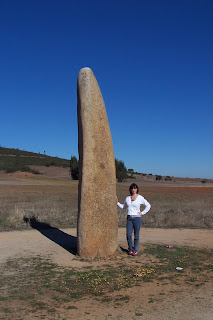Antequara Dolmens
The important natural routes of southern 
Megaliths or “menhirs” were already seen near Monsaraz.
Imagine figuring out how to raise a slab of this size using the tools available to Neolithic man. Now imagine using a number of them to construct something. Dolmens are megalithic constructions made up of vertical rock slabs that support one or more horizontal slabs that serve as a roof, thus forming a gallery. Intended usually for collective burial they come in a variety of sizes.
The simplest like those at Menga (
The El Romeral dolmen in  . The Zambujeiro example is the largest dolmen in
. The Zambujeiro example is the largest dolmen in
At the dolmen, the protective roof unfortunately casts obscuring shadows. But the now largely roofless corridor/galley can be identified by the vertical slabs. The tholos is at the end of the corridor and entrance to it is blocked by the recently installed wood framing that supports the remaining corridor roof.
But the now largely roofless corridor/galley can be identified by the vertical slabs. The tholos is at the end of the corridor and entrance to it is blocked by the recently installed wood framing that supports the remaining corridor roof. 
These burial monuments, originally covered by a mound of earth and stones, appear today as the skeleton of a structure; nonetheless they are still imposing in their mass and arrangement.
They were built by people forming the first nuclei of settlement in this area using the fertile plains as a source of food cultivation thus permitting more or less permanent location. The first open air settlements date from the Copper or Calcolithic Age (2500 to 1800 B.C.). Animal grazing was added to the agriculture as time passed and they began to make use of copper and later bronze.
Contrasted with the Neolithic society (5000 to 3000 B.C.) the social group that moved megaliths and constructed dolmens were socially stratified. Imagine the amount of coordinated work it took to locate, relocate and erect a number of megaliths as large as the one pictured above with Marie-Claire (as a size reference).
The interior of the more or less circular tholos, the burial chamber is approximately 7 meters across. 
 Ideas about death began to change and death rites acquired great importance. Group burial takes over from the individual burials of the Neolithic Age.
Ideas about death began to change and death rites acquired great importance. Group burial takes over from the individual burials of the Neolithic Age.
Presumably burial in a dolmen assured life after death since various utensils were placed beside the bodies especially metal ones in everyday use.
This example has a beautiful view looking out the gallery and over the countryside.


<< Home